Although the original length and grandiosity is not entirely preserved, the “Gruta do Carvão” cave system displays a large variety of geological features, typical of effusive volcanism and it is an important speleological monument.
On the roof, countless stalactites of various shapes can be seen. The lava stalactites are primary features that result from the fast cooling process of the lava dripping from the roof. Most of them have a very smooth surface and conical shape.
When lava dripping down from the roof accumulates on the floor of the lava tube it originates stalagmites, another common structure in volcanic caves, that frequently exhibit a globular/reniform form with a large base.
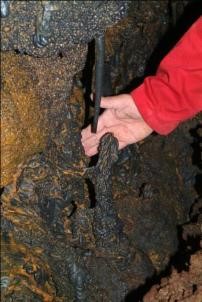 Lava stalactite and stalagmite
Lava stalactite and stalagmite
There is another type of stalactites, the secondary stalactites of amorphous silica, these are mainly irregularly shaped, very fragile and present a whitish color. These features result of the accumulation and chemical alteration of the water that inflitrate from the surface and precipitate on the roof.
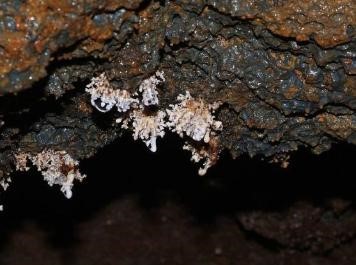 Secondary stalactites of amorphous silica
Secondary stalactites of amorphous silica
This meteoric water is also responsible for the oxidation of the basaltic rocks of which the cave is made of. This leads to a colour change (to reddish or orangish) near the cracks and other infiltration zones. This colour change is devoted to the alteration of basalt magnetite to secondary minerals, namely limonite and hematite.
In lava tubes it is also common the presence of prominent structures on the lateral walls, the lateral benches, which are "records" of the various levels of lava flows that travelled through the tube system.
 Lateral Benches
Lateral Benches
When the lava flowing inside the tube allows the lateral benches to grow in a lateral direction they may unite in a certain point, forming a lava bridge that connects both walls.
 Lava Bridge
Lava Bridge
Also a result of the lava flow inside the tube, striae on the walls ( found specially on the concave areas of the tube) indicate the flow direction and are associated to thermal and mechanical erosion.
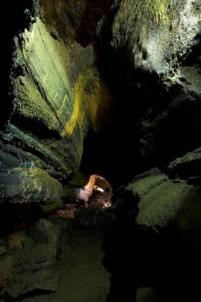 Striations resulting from the lava flow
Striations resulting from the lava flow
During the cooling process of the lava tube walls the pressure of the gases accumulated inside them will sometimes lead to explosions in the superficial layer of the walls originating another vulcano-speleological structure, burst bubbles of gas.
Fractures in the walls and roof of the tube may have different origins: due to cooling induced contraction, earthquakes (a common event in the Azores) or human activities at surface.
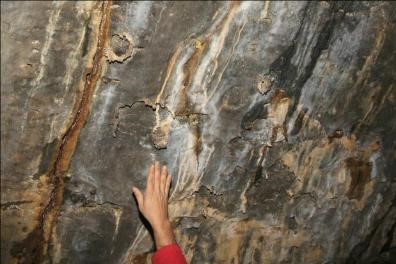 Gas Bubbles and Cracks
Gas Bubbles and Cracks
Sometimes, large rock fragments from walls and roof collapses are involved and aggregated by the lava flowing inside the tube forming structures named "lava balls".
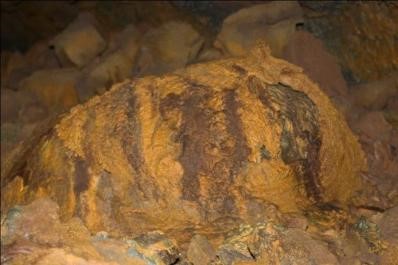 Lava Ball
Lava Ball
Most of the walls and roofs of volcanic caves are covered by a smooth and thin layer of metallic luster (glaze) that overlays the spongy textured basalt. This happens because basalt suffers a remelting process due to the high temperatures and pressures of the lava flows and gases inside the tube.
The floor of the cave is primarily covered by aa lava type, which is characterized for having an irregular and rough texture and some loose fragments of variable dimensions that are often welded together, called clinker. A smaller portion of the cave is covered by a more homogeneous, flat and slightly undulated surface made up of pahoehoe lava.
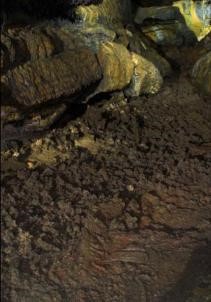 aa lava (left) and pahoehoe lava (right)
aa lava (left) and pahoehoe lava (right)
All these vulcano-speleological structures strenghten the importance of the "Gruta do Carvão" in the process of learning and interpreting correctly the basaltic volcanism on São Miguel island.



